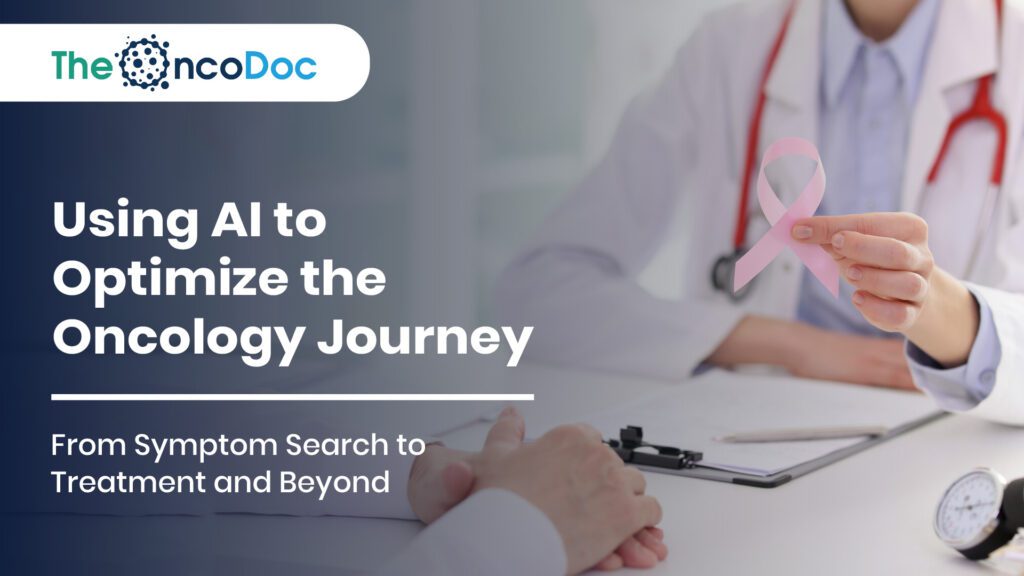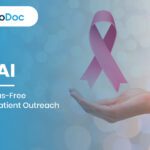Introduction: Redefining the Oncology Pathway with AI
Cancer care has evolved beyond hospital walls and clinical settings. Today, the oncology journey begins when a patient first searches online for unexplained fatigue, a lump, or persistent pain. At each step, from symptom awareness to diagnosis, treatment, and survivorship, AI is becoming the invisible engine guiding patients, physicians, and pharma marketers toward smarter decisions.
For pharma marketers, this means moving beyond awareness campaigns to becoming partners in a patient’s entire oncology journey. AI enables proactive engagement, predictive interventions, and real-time personalization that can transform outcomes.
This article explores how AI can optimize each stage of the oncology pathway while positioning pharma as a trusted ally in improving survival and quality of life.
1. AI in Symptom Search and Early Awareness
Patients often start their cancer journey with a simple online query. Unfortunately, generic search results can confuse or mislead. AI-powered platforms now analyze search behavior to provide context-sensitive education.
- AI chatbots embedded in search engines offer symptom explanations with evidence-backed clarity.
- Predictive modeling highlights individuals at higher risk based on search history, nudging them toward screening centers.
- Pharma brands can integrate localized awareness content into these touchpoints, building credibility from the very first patient query.
This makes the first step of the journey both educational and trustworthy rather than anxiety-inducing.
2. Hyper-Personalized Screening Nudges
AI bridges the gap between symptom recognition and screening uptake. Predictive algorithms can identify who is likely to delay diagnosis and provide tailored reminders.
- Behavioral nudging: A smoker searching for chronic cough content receives targeted screening prompts.
- Geo-based interventions: AI detects areas with low screening rates and pushes campaigns via local influencers.
- Adaptive messaging: Reminders evolve depending on whether patients respond or ignore previous nudges.
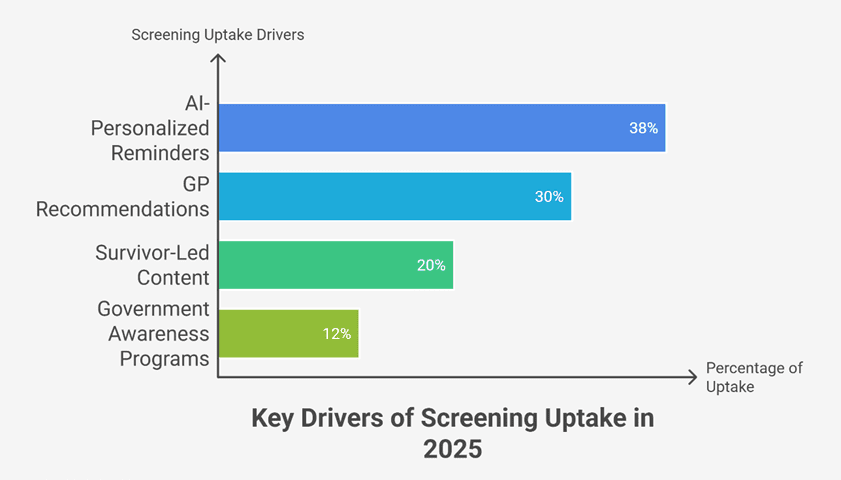
3. AI Empowering General Practitioners (GPs)
GPs remain critical in early detection but often miss subtle cancer indicators. AI supports them through:
- Decision-support dashboards suggesting differential diagnoses when cancer is suspected.
- Training micro-modules via WhatsApp or mobile apps, updated with regional cancer patterns.
- Referral mapping that identifies nearby oncology specialists and diagnostic centers.
By empowering GPs, pharma companies position themselves not only as drug providers but as educational enablers.
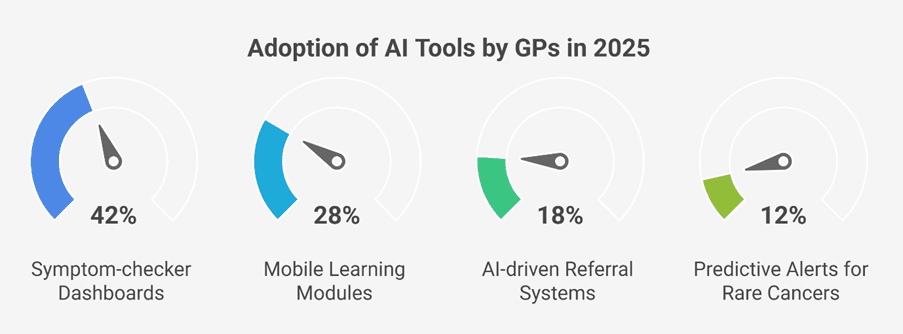
4. Omnichannel Patient Engagement Powered by AI
The oncology journey is rarely linear, patients often shift between online research, consultations, caregiver advice, and survivor-led communities. This fragmented experience can create confusion or inconsistency in the information they receive. AI-driven omnichannel strategies solve this challenge by ensuring patients encounter a continuous, unified message across all platforms.
- Voice-based FAQs help rural populations with limited literacy, providing accessible information in regional languages.
- Personalized video feeds deliver survivor journeys that resonate with patients’ demographics and conditions, offering both education and emotional reassurance.
- Mobile reminders synced with wearable data prompt timely screenings, follow-ups, and treatment adherence, ensuring no critical step is missed.
- AI-enabled clinic kiosks allow patients to complete multilingual self-assessments and receive instant guidance.
This consistent engagement fosters familiarity, reduces anxiety, and reinforces pharma’s role as a reliable guide throughout the patient’s care pathway.
5. Emotional AI for Reducing Fear
Fear, denial, and misinformation are among the greatest barriers to early oncology intervention. Emotional AI uses sentiment analysis to decode patient reactions, enabling communication that is empathetic rather than overwhelming.
- Tone-adjusted messaging adapts in real time depending on whether users display fear, anger, or uncertainty in their responses.
- Positive survivor narratives are strategically highlighted to anxious audiences, shifting focus from despair to hope.
- Simplified communication filters strip away intimidating medical jargon for patients with low health literacy.
By blending emotional intelligence with data-driven personalization, pharma companies can transform fear-driven avoidance into proactive decision-making, nudging patients toward screenings and consultations.
6. AI-Powered Content Personalization Across Platforms
Generic cancer information no longer engages today’s digitally savvy patients. AI creates hyper-personalized education tailored to each individual’s behavior, risk profile, and cultural background.
- A 30-year-old woman searching “irregular periods” receives targeted ovarian cancer awareness content with preventive guidance.
- A middle-aged smoker is served oral cancer screening prompts in his regional language, increasing comprehension and relevance.
- Caregivers researching “chemotherapy side effects” are provided with practical guides and stress management resources, addressing both medical and emotional needs.
Such personalized outreach transforms abstract awareness campaigns into directly actionable resources, making patients feel understood and supported.
7. Predictive AI for Regional Oncology Trends
Pharma marketing is shifting from reactive campaigns to predictive, data-led interventions. AI analyzes diverse data streams, search spikes, wearable health indicators, and prescription trends, to anticipate cancer risks at the regional level.
- For example, a sudden increase in “persistent cough” searches within a district could signal an emerging lung cancer burden. AI alerts enable pharma companies to launch localized awareness drives before cases escalate.
This foresight empowers pharma to act as a proactive health partner, delivering timely interventions that save lives while strengthening brand trust.
8. Vernacular AI Campaigns for Inclusivity
Cancer awareness is most effective when rooted in culture and language. Vernacular AI ensures that outreach resonates with local audiences by making it contextual and inclusive.
- Automated translations of oncology content into more than 20 dialects break linguistic barriers.
- Cultural adaptations like folk songs, street plays, or radio jingles deliver awareness in familiar formats.
- AI-powered voice assistants support populations with low literacy by answering cancer-related FAQs in conversational language.
By embedding cultural and linguistic nuance, pharma builds credibility, enhances comprehension, and ensures oncology communication truly reaches every community.
9. AI-Supported Oncologist Dashboards
For oncologists, AI simplifies complexity:
- Literature summarization: AI curates the latest trial results.
- Patient risk stratification: AI flags high-risk patients for priority follow-up.
- Peer networks: AI platforms connect oncologists for rare case discussions.
Pharma brands sponsoring these tools position themselves as knowledge partners rather than marketers.
10. Shifting KPIs from Clicks to Clinical Impact
AI also redefines what success means in oncology marketing.
- Instead of measuring ad clicks, KPIs include:
- Screening registrations
- GP referrals generated
- Chatbot symptom assessments completed
- Survivorship program participation
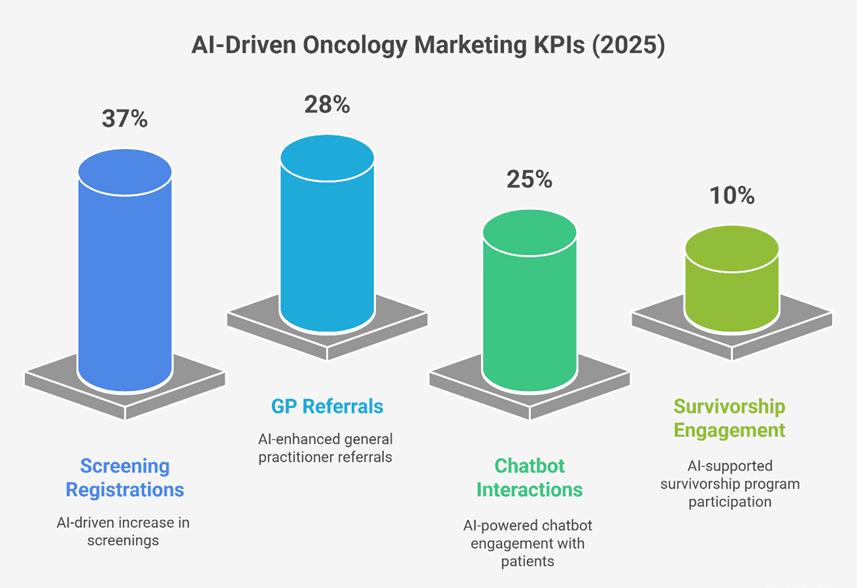
11. Collaborating with Survivor Influencers
AI helps identify cancer survivors with strong engagement potential by analyzing social media traction, sentiment scores, and community impact. These survivor influencers bring unparalleled authenticity to oncology awareness, as their lived experiences resonate more deeply than corporate messages.
- Localized awareness drives led by survivors ensure campaigns feel grassroots rather than top-down. Their presence in schools, community centers, and digital forums builds trust among audiences.
- AI-powered Q&A sessions allow survivors to answer patient questions in real time, with algorithms curating the most common concerns to maximize impact.
- Virtual mentorship clubs connect survivors with newly diagnosed patients, offering both emotional reassurance and practical guidance.
By facilitating survivor-led storytelling, pharma brands position themselves as enablers of real voices and real hope, shifting from product promotion to community empowerment.
12. Gamification of Oncology Awareness
Cancer awareness often struggles against inertia, as patients delay screenings or ignore subtle symptoms. AI-driven gamification transforms health engagement into an interactive, motivating experience.
- Symptom quizzes reward participants with “health badges,” turning learning into an achievement-based journey.
- District-level screening competitions encourage entire communities to participate, with recognition given to regions showing the highest turnout.
- Virtual rewards and milestones incentivize patients to complete screenings or follow lifestyle recommendations.
Gamification reframes cancer care as a collective mission, encouraging proactive participation from patients, families, and communities. It not only boosts engagement but also makes awareness campaigns memorable and shareable.
13. AI Integration with Wearables
The rise of wearables has created a new frontier in oncology, where AI transforms raw health data into actionable insights.
- Vitals tracking detects anomalies such as sudden weight loss, abnormal heart rates, or sleep disruptions, potentially signaling early warning signs.
- Preventive nudges remind individuals to schedule checkups or screenings when wearable data shows deviations from healthy norms.
- Treatment monitoring allows oncologists to remotely track chemotherapy side effects in real time, intervening before complications escalate.
This integration ensures patients receive continuous, AI-enabled support well beyond clinic walls, reinforcing adherence and early intervention.
14. Partnerships with Governments and NGOs
AI-generated insights are increasingly guiding collaborative oncology initiatives between pharma, governments, and NGOs.
- Hotspot identification highlights underserved regions with high cancer risk but low awareness, ensuring resources are directed where most needed.
- Policy-driven campaigns are supported by AI data that demonstrates measurable impact, making advocacy efforts more persuasive.
- AI-enabled screening camps, co-sponsored by pharma and NGOs, expand access while reducing operational inefficiencies.
These collaborations magnify reach, enhance credibility, and align pharma efforts with national cancer control priorities, showcasing the industry as a social health partner rather than a commercial entity.
15. Building Virtual Cancer Communities
Pharma brands are increasingly nurturing digital-first ecosystems where patients, survivors, and caregivers find support. AI ensures these spaces remain safe, informative, and impactful.
- AI moderation tools filter misinformation and promote fact-based discussions, safeguarding community trust.
- Survivor mentorship provides authentic narratives, inspiring patients to pursue early treatment and adhere to therapies.
- Wellness resources like stress management sessions, dietary guidance, and emotional counseling are personalized for each member.
These AI-managed communities evolve into long-term wellness ecosystems, where pharma transitions from being a distant provider to a trusted partner in survivorship care.
16. AI-Powered Voice Tech and IVR
Voice-first AI campaigns break literacy barriers:
- Symptom checkers accessible via WhatsApp voice notes.
- IVR helplines offering step-by-step screening guidance.
- Regional voice bots providing oncology FAQs.
This ensures no patient is left behind due to language or literacy gaps.
17. AI in Myth-Busting and Social Listening
Misinformation remains one of the most dangerous barriers to early detection and treatment in oncology. False claims such as “herbal cures for cancer” or “chemotherapy causes more harm than good” spread rapidly on social media. AI-powered social listening tools scan digital conversations, flagging harmful narratives in real time.
- Instant counter content is deployed, ensuring patients and caregivers quickly access accurate facts.
- Oncologists share fact-check videos, lending credibility and professional authority.
- Survivor voices are amplified, as personal testimonies often resonate more strongly than clinical explanations.
Through this, pharma brands evolve into guardians of truth, ensuring that accurate, empathetic information overrides harmful myths.
18. AI for Post-Treatment Engagement
Cancer care continues well beyond remission. Survivors often struggle with late side effects, lifestyle changes, and emotional well-being. AI creates structured, long-term engagement pathways.
- Mobile apps track side effects and instantly alert doctors to potential complications.
- Survivorship dashboards provide personalized diet, exercise, and recovery plans.
- AI-based mood trackers recommend mindfulness practices or connect patients to counselors when distress signals are detected.
By addressing survivorship holistically, pharma strengthens trust and builds lifelong patient loyalty.
19. Survivor Clubs as AI-Enhanced Communities
Survivor-led communities are powerful drivers of hope and awareness. AI scales their reach and optimizes their impact.
- Predictive mapping identifies regions most in need of survivor presence.
- Smart matching pairs survivors with patients of similar demographics or cancer types for deeper connections.
- Impact measurement tools track digital engagement and attendance, ensuring accountability.
These AI-enhanced survivor clubs become data-driven outreach hubs, combining emotional authenticity with measurable results.
20. Future of AI in the Oncology Journey
The future blends predictive AI, personalization, and prevention:
- Digital twins simulating individual responses to therapies.
- AI detecting cancer risks even before symptoms surface.
- Emotion-driven campaigns focusing equally on mental resilience and clinical care.
Pharma brands that embed themselves into this symptom-to-survivorship journey will not just market drugs, they will redefine oncology care itself.
Conclusion
AI is not just a technology layer, it is the connective tissue of the modern oncology journey. From a patient’s first online query to survivorship support, AI ensures every touchpoint is educational, empathetic, and actionable.
Pharma marketers who leverage AI responsibly will no longer be seen as product promoters but as lifelong partners in cancer care. Success will be measured not by digital impressions but by the number of patients diagnosed early, treated effectively, and living longer, healthier lives.
The Oncodoc team is a group of passionate healthcare and marketing professionals dedicated to delivering accurate, engaging, and impactful content. With expertise across medical research, digital strategy, and clinical communication, the team focuses on empowering healthcare professionals and patients alike. Through evidence-based insights and innovative storytelling, Hidoc aims to bridge the gap between medicine and digital engagement, promoting wellness and informed decision-making.

